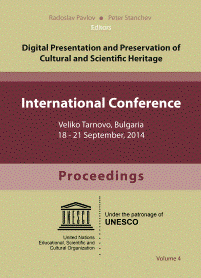Preservation of the Cultural Heritage of the Armenians in Diaspora
The Role of the Church in Preserving the Cultural Heritage: The Example of the Armenians in Rome, Italy
DOI:
https://doi.org/10.55630/dipp.2014.4.34Keywords:
Cultural Heritage, Preservation, Church, Diaspora, Armenians in RomeAbstract
This article refers to the role of the Church as an institution which is important for the preserving the cultural heritage of the ethnic communities in the Diaspora and, in particular, how the Armenian Catholic Church in Rome is involved in the preservation of the tangible and intangible cultural heritage of the Armenians in the Italian capital city.References
Church of St. Nicolas of Tolentino. Rome, Aramagan design (2014).
Garabedyan, A.: Formirane na armenskata obshtnost i neinata rolia v razvitieto na bulgarskata darzhava [Formation of Armenian Community and Its Role in the Development of Bulgarian State]. In: Bulgari I armenci zaedno prez vekovete [Bulgarians and Armenians Together for Centuries] (in Bulgarian). Sofia, Tangra TanNakRa, pp. 231-272 (2001).
Giligyan, A.: Armenski nadgrobia po bulgarskite zemi v perioda na osmanskoto vladichestvo (XVII - XIX в .) [Armenian Tombstones in the Bulgarian Lands during the Period of Ottoman Rule]. In: Bulgarski Folklor [Bulgarian Folklore] (in Bulgarian). Vol. 1-2, pp. 129-135 (1999).
Giligyan, A.: Armenski nadgrobia v Ruse: Nadgrobni plochi i pametnici v dvora na armenskata curkva “Surp Astvadzadzin” (“Sveta Bogorodica”) – XII-XIX v. [Armenian Tombstones in Rousse: Gravestones and Monuments in the Courtyard of Armenian Church Surp Astvadzadzin (St. Marry) – XII-XIX. In: Izvestia – Regionalen istoricheski muzei – Ruse [Proceedings of the Rousse Regional Museum of History] (in Bulgarian). Vol. 7, pp. 68-77 (2002).
In May 2014 a field research was conducted by Nadya Vladimirova in Rome due to the financial support of Project BG-051PO001-3.3.06.0055 “Creating an Information Environment that Motivates and Provides Incentives for Young Researchers at the SULSIT” under Grant Scheme “Support for Development of Doctoral and Post-doctoral Students, Graduates Pursuing Specialists Studies and Young Researchers” of the HRD Program cofinanced from the ESF of the EU.
Lang, D.: The Armenians: a People in Exile (in English). London (1981).
May 20, 1985 established by Law no. 222.
Mitseva, E.: Armencite v Bulgaria – kultura I identichnost [Armenians in Bulgaria – Culture and Identity] (in Bulgarian). Sofia, Imir (2001).
Pane, R.: La Chiesa Armena, Storia, spiritualità, Istituzioni [The Armenian Church, History, Spirituality, Institutions] (in Italian). Bologna (2011).
Pontifical Armenian College, Pontificiocollegioarmeno.org 11.07.2014 <http://www.pontificiocollegioarmeno.org/>
Regolamento del Pontificio Collegio Armeno, Tipografia Poligliotta [Rules of the Pontifical Armenian College, Typography Poligliotta] (in Italian). Roma (1883).
Such as January 6 (Epiphany of the Lord), February 3 - Feast of St. Blaise of Sebaste; Commemoration of Martyrs and St. Vartan Avarayr - last Thursday before Lent; April 24 - Commemoration of the Genocide of the Armenian people. St. Blaise, the bishop of Sebaste in Armenia is given a special recognition on February 3 by the Armenian Church in Via Giulia, not only with the divine liturgy but with a unique ceremony that parallels the practice of anointing the sick.
The College has hosted several high-level initiatives, including synods and historical conferences. It gave the Armenian Catholic Church priests who have distinguished themselves for their wise and holy life. Among them a special remembrance of the great and humble intellectual deserves Rev. Father Gregory Petrovich.
There is no official statistics on the number of the Armenian community in Rome. This information is based on observations of Robert Badichah.
This applies to the Armenian churches in city of Plovdiv, Pazardzhik, Sofia, Rousse, and Varna.
UNESCO Doc. 33 C/23 of 4 August 2005.
Vladimirova, N.: Aktualno sustoianie I problemi na opazvaneto I sahraniavaneto na dvizhimoto religiozno KIN na armencite v Plovdiv I Burgas: danni ot terenno izsledvane 2013 g. [Current Status and Problems of Conservation and Preservation of Movable Religious Cultural Heritage of Armenians in Plovdiv and Burgas: Data from Field Research in 2013]. In: Studentski digitalen arhiv po religiozno kulturno-istorichesko nasledstvo [Student Digital Archive on Religious Heritage] (in Bulgarian). Vol. 2, pp. 208-219 (2013).
Zandri, G.: S. Nicola da Tolentino [St. Nicolas of Tolentino] (in Italian). Istituto Nazionale di Studi Romani [National Institute of Roman Studies], Rome (1987).




